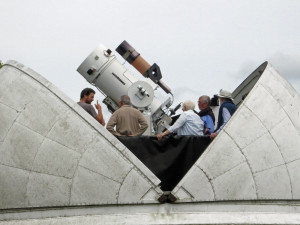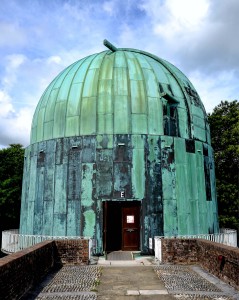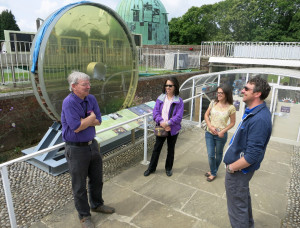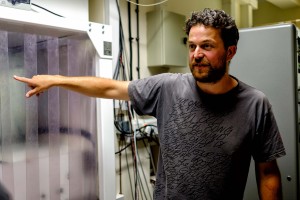June 28, 2014
Trip to Herstmonceux: June 2014
Report by Mike Meynell
In truth, the Flamsteed don’t need much of an excuse to organise a trip to Herstmonceux, the second home of the Royal Greenwich Observatory. However, it was a bit of a surprise to find that it had been 6 years since our last visit, back in June 2008.
It was the formation of two “special interest groups” within the Flamsteed in the last couple of years – the Radio Astronomy Group and the History of Astronomy Group – that provided the catalyst for arranging this visit. Herstmonceux has a very active radio astronomy group, who were happy to provide advice to our burgeoning group of radio astronomers, whereas the history of astronomy aspects of the trip were of clear interest to many of our members. As an added bonus, we’d also managed to arrange a tour of the Space Geodesy Facility, a nearby research facility that actively supports geodetic and geophysical science.
A good turnout of 30 Flamsteed members met early on Saturday morning at the Observatory Science Centre in Herstmonceux, initially to go on a tour of the six historic telescope domes. Our guide first took us to dome E, which houses the 26-inch Thompson Refractor. This telescope was originally installed in the dome of the South Building at the Royal Observatory in Greenwich. I found some interesting Pathe News footage of this telescope, which has been posted on the forums, along with some photos of the South Building Dome with the telescope in place, and then following its conversion in recent years into the Endeavour Room.
An interesting aspect of the 26-inch Thompson Refractor is the guiding telescope. This scope is none other than Airy’s “Great Equatorial” 12.8-inch refractor, which was first mounted in the Great Equatorial Building at Greenwich in 1860. When the 28-inch refractor replaced this telescope, it was given a new tube and mounted on the 26-inch telescope in 1891. This combination remained when the telescope and guiding scope were re-erected at Herstmonceux in 1957.
The floor of dome E is a giant lift, so that the floor can rise to give observers a convenient viewing point to look through the telescope, without the use of ladders, if the scope is pointed towards objects lower down in the sky.
We then moved on to dome D, which houses the 13-inch Astrographic Refractor. Apart from the guiding telescope of the 26-inch Thompson Refractor, this is the oldest telescope on site, having been mounted at Greenwich in 1890. It was originally mounted in the Astrographic Dome at Greenwich, above the meridian building, before being moved to Herstmonceux in 1958. The telescope was used for direct photography, originally for the international Carte du Ciel, and then to measure the “proper motion” of stars along with observations of Solar System objects. The object glass of the telescope was also used to observe several eclipses around the world, including the 1919 eclipse in Brazil that proved the validity of Einstein’s theory of relativity.
In dome B, we found the 36-inch Yapp Reflector. This was originally mounted at Greenwich between 1934 and 1955, in a 2-storied observatory within the Christie enclosure in Greenwich Park. All of the buildings in the Christie Enclosure were demolished in 1956-7, with the land returned to Greenwich Park (a forum thread about the Christie Enclosure can be found here). The Yapp telescope was used primarily for the measurement of the colour temperatures of stars using a spectroscope.
Moving over to dome A is the 30-inch Thompson Photographic Reflector. When first installed at Greenwich in 1897, it was placed on the same mount as the 26-inch Thompson Refractor, at the opposite end of the declination axis, thus rather limiting the use of both telescopes. Using this telescope, Melotte discovered the eighth moon of Jupiter in 1908.
Crossing back to dome C, we found the 30-inch Hewitt Camera. This was originally designed in the 1950s in order to track the ill-fated “Blue Streak” ballistic missile, but, after the cancellation of this programme, it was used to track satellites. Each image taken by the camera covers an area of sky 20-times that of the full Moon.
Finally, with the formal tour at an end, we went to dome F, which houses the 38-inch Congo Schmidt telescope, a scope that perhaps we shouldn’t dwell on for too long! Originally designed for an observatory in the Belgian Congo, the outbreak of civil war meant that it could not be installed. When moved to Herstmonceux, it was discovered that the optics were so poor that, to all intents and purposes, the telescope was unusable. Moving on swiftly…
Space Geodesy Facility
After lunch, it was time for our tour of the Space Geodesy Facility (SGF), a 10-minute walk from the Observatory Science Centre. Rob Sherwood, the Operations Manager of the SGF, had come in especially on Saturday afternoon to take us on the tour, for which we were extremely grateful.
The SGF operates a Satellite Laser Ranging (SLR) station, which can measure distances to satellites within an accuracy of around 5mm! By doing this, it is possible to determine tectonic drift on the Earth to an accuracy of millimetres per year, allowing modelling of the interior processes of the Earth.
Interestingly, the building and dome that contains the Satellite Laser Ranging station was the first building constructed at Herstmonceux in 1949. It was originally a solar observatory to monitor sunspot activity, using the 6.25-inch Newbegin refractor and a Dallmeyer photoheliograph, but was converted to laser ranging in the early 1980s.
The laser is in a tube mounted on the main telescope, which then detects the returned beam. The other small dome on the building contains radar that can turn off the laser if an aircraft passes over.
The site also contains a Global Navigation Satellite System, which provides another method for determining geodetic data by comparing the broadcast time of the satellite signal with the time received on the ground.
Rob took us on a tour inside the facility. He explained that there are three main components to a SLR, the laser, the detector and the timer. Rob explained that the main advances in accuracy of measurements have come about through improvements in the timers. Fifty years ago, it was only possible to make measurements to an accuracy of half a metre… now it is down to millimetres. One of the lasers used at the SGF is the same one as installed in the 1980s. Detectors have improved over this time, but the main advance has been in the timing equipment, determining the time between the firing of the laser and the return pulse. This can now be determined to an accuracy of picoseconds.

The SLR satellite laser ranging station
“..but can we defeat Ming the Merciless?” Rob gives us the rundown on the SLR equipment
Rob showed us an example of a retro-reflector, which are installed on satellites in order to reflect the laser light back to the detector. Even the shape of the satellite has to be taken into account to make an accurate measurement. Modern satellites now have a single point reflector so that this can be determined accurately.
The SGF has two lasers for laser ranging. The first laser fires in short pulses, 100 picoseconds in duration, at a rate of 12 pulses per second. The second laser generates shorter, 10 picosecond pulses, which are less energetic, but fires more rapidly at 2000 times per second.
Rob then took us upstairs to the telescope dome to view the telescope, detector and laser. The telescope is a Cassegrain reflector design, with a 600mm aperture, which can point very accurately to an object in the sky. The telescope needs to be able to slew quickly and accurately, to track fast moving satellites. Mounted on the side of the telescope is a smaller telescope through which the laser is emitted.
The detector is used to detect the few photons that make the round trip from the laser system to the satellite and back. The chip within the detector is cooled to around -60°C.
Rob took us through the process for choosing a satellite and then slewing the scope and firing the laser. It was particularly interesting to see how fast the scope had to move for satellites lower down in Earth’s orbit. Satellites range in height from around 300km to 42,000km above the surface of the Earth.
Our thanks to Rob for a really fascinating tour, and we wish him the best of luck in his future endeavours.
Returning to the Observatory Science Centre, several of our group went to visit the Radio Astronomy Group at Herstmonceux for a chat about radio astronomy. During our visit, we were shown real-time reception of radio signals from the Sun using Radio JOVE equipment. This may be something that would complement our existing VLF receiver, so is currently being investigated by the Flamsteed Radio Astronomy Group.
So ended our day at Herstmonceux. The weather stayed fine all day (unlike in London!) and it was wonderful to spend the day with such good company and in such glorious countryside.
Thanks to everyone who attended and special thanks to the Observatory Science Centre and to Rob Sherwood at the Space Geodesy Facility for their superb hospitality. I’m sure we will be returning to Herstmonceux again, one day soon.
Pictures from the trip (by Mike Dryland and Mike Meynell):
Further pictures from the trip (by Grey Lipley):
Posted under: Flamsteed, Society Trip

















































































You must be logged in to post a comment.